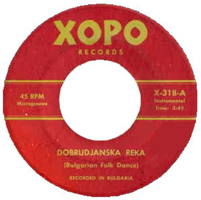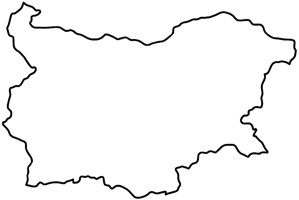
|
The Society of Folk Dance Historians (SFDH)
About Dobrudžanska Rŭka
[
Home |
About |
Encyclopedia | CLICK AN IMAGE TO ENLARGE |

|

This dance was initially introduced to North America among Canadian folk dancers. The Bulgarian word "рвка" was transliterated "reka" on both the dance notes and the XOPO 45 record prepared for the benefit of French speakers, for whom the unaccented "e" has the value "uh." English-speaking folk dancers often mistakenly give the "e" the Continental value, "eh." As a result the dance is incorrectly pronounced "REH-kah" (rather than "RUH-kah") in the United States.
In Dobrudža (northeast Bulgaria), Sunday afternoons were regular social occasions involving the whole village, and were spent in gossiping, eating, drinking, singing, and dancing. These weekly gatherings afforded the villagers the opportunity to join in a rich repertoire of circle and line dances, chief among which was Rŭka.
The distinguishing feature of any dance called Rŭka was that its participants joined hands and moved their arms in various patterns to accompany their other movements, whereas in other dances they grasped neighbors' belts or used a crossed basket hold.
Dobrudžans usually danced Rŭka in an open or closed circle made up of men and women. Often the men broke from the mixed line after a while to form their own line and proceeded to perform highly complex movements involving additional arm movements, deep knee-bends, etc., at which point the women either continued dancing in their own line or stopped dancing and watched the men. This dance is based on a segment from a larger choreographed suite of Dobrudžan dances in the repertoire of the Ansambl Sredec of Sofia, Bulgaria. In its original setting it was intended by the choreographer to feature the women dancers at a particular moment in the suite, which also included men's and mixed-dancer segments. In this sense, it is a "women's" dance.
Camille Brochu learned the dance in Sofia from Ansambl Sredec during the summer of 1968. Yves Moreau later worked on the dance in Sofia himself. Although choreographed for stage in Sofia, the steps and style are based on those movements found in the Dobrudžan ethnographic region. A Dobrudžan men's dance complemented this women's dance on stage.
The dance has also been notated as "Dobrudjanska Râka," "Dobrudjanska Reka," "Dobrudjanska Rŭka," "Dobrudžanska Râka," and "Dobrudžanska Reka."